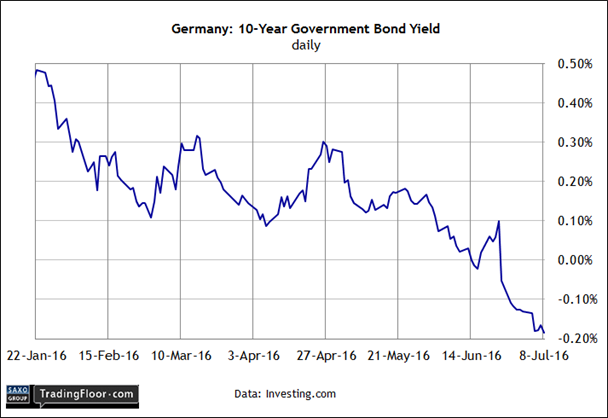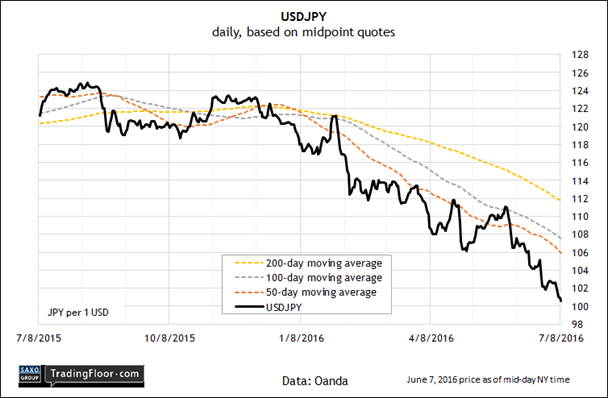- Will the German 10-year yield fall below negative 0.20% this week?
- USD/JPY looks set to dip below ¥100 for the first time since late 2013
- The 287,000 surge in nonfarm payrolls is the strongest advance in eight months
- Fed’s Labour Market Conditions Index may confirm the upbeat payrolls data
Monday’s a light day for economic news, although two striking market trends deserve close attention as a new trading week kicks off. The German 10-year yield has been inching ever deeper into negative territory in recent weeks and we may see the first print below negative 0.20% in the days ahead.
Meanwhile, USD/JPY appears set to dip below the ¥100 mark for the first time since late 2013. As for macro releases, the Federal Reserve publishes its monthly update of its Labor Market Conditions Index, which will provide deeper context for assessing the sharp rebound in US job growth in June.
German 10-Year Bond Yield: The remarkable descent in the 10-year bund yield is a thing to behold. Europe’s largest economy is growing at a modest pace, albeit unspectacularly.
But the outlook calls for a relatively steady expansion for the rest of the year. True, the IMF recently downgraded its forecast for the German economy to 1.7% in 2016, dipping to 1.5% next year. But while slow growth is worrisome, the bond market appears to be pricing in the apocalypse.
It’s striking to see one of the world’s biggest and strongest economies linked to modestly negative interest rates. As of last Friday, the 10-year yield inched closer to minus 0.20% and it appears that this key rate for Europe is heading even lower.
The sub-zero yields are mostly a reflection about Eurozone worries, which have become exacerbated after the uncertainty surrounding last month’s vote in the UK to leave the European Union.
As the safest haven in the euro area, Germany’s bonds are becoming a crowded long trade in the extreme, a bit more so with each passing day.
Adding to the downward momentum is the European Central Bank’s ongoing QE program (buying assets with newly printed money) and expectations that the ECB may be forced to ramp up its liquidity injections if the post-Brexit blow back accelerates.
The fact that so many investors are eager to hold a safe investment that is destined to lose money tells you a lot about sentiment these days. The implied message: Fear trumps hope, and a catalyst that will brighten the mood in a meaningful degree is nowhere on the horizon.

USD/JPY: In the spectacle that is the global economy, few trends are as striking as Japan’s weak economy and its strengthening currency.
Unfortunately, the strong yen will probably create even more headwinds for the world’s third-largest economy. The question is: what can the Bank of Japan do to slow or reverse the trend?
Currency intervention is on the short list, and some analysts think the Bank of Japan is gearing up for another attempt at forex manipulation. But history suggests this tool kit’s efficacy is limited.
“The historical track record is discouraging,” according to Marcel Thieliant of Capital Economics via CNNMoney. In two previous interventions, “The yen continued to strengthen despite strong purchases of foreign currency”.
Meantime, the rising yen continues to take an economic toll. “The appreciation in yen is a grave threat to Japanese policy makers as the depreciation in yen between 2012 and 2015 was instrumental in their efforts to reflate the economy,” noted Japan Macro Advisors last week.
But more pain may be coming. The firm’s chief economist told Bloomberg recently that “there is significant risk the yen could increase very sharply to 90 yen against the dollar”.
The technical profile for USD/JPY doesn’t disagree. Indeed, the downside momentum remains intact in no uncertain terms. The greenback ended last week at roughly ¥100.55. If this year’s strong trend is a guide, USD/JPY may be close to slipping below ¥100 in the days ahead for the first time since November 2013.
Will USD/JPY trading below ¥100 trigger intervention by the Bank of Japan? Not yet, according to JMA.
The consultancy’s modeling predicts that intervention is “quite unlikely” until USD/JPY touches 95. But considering the strength of USD/JPY's slide, the tipping point may be near.

US: Labor Market Conditions Index (1400 GMT): Friday’s surprisingly strong increase in payrolls in June suggests that the US economy is still on track to expand at a moderate rate.
Although the weak gain in May raised fears that a new recession was lurking, the labour market’s rebound tells a different story.
The 287,000 surge in headline payrolls last month marks the strongest advance in eight months. By some accounts, the report is strong enough to put a Fed rate hike back on the radar for the near term.
The Wall Street Journal’s Jon Hilsenrath, one of the most well-connected journalist on Federal Reserve matters, wrote on Friday that the latest numbers “increase the odds of a rate move as early as September”.
Perhaps, but let’s see how the Fed’s broad-minded benchmark on the labour market trend compares. Today’s release will be widely read in the wake of a worrisome deterioration in recent months. The Labor Market Conditions Index (LMCI) has declined ever deeper into negative territory in each and every month this year through May, marking the weakest run of numbers since the last recession.
The upbeat report on payrolls implies that LMCI will rebound in June. But if this multi-factor benchmark slides deeper into the red for June, the news will pare back some of the optimism unleashed in Friday’s release.

Disclosure: Originally published at Saxo Bank TradingFloor.com
